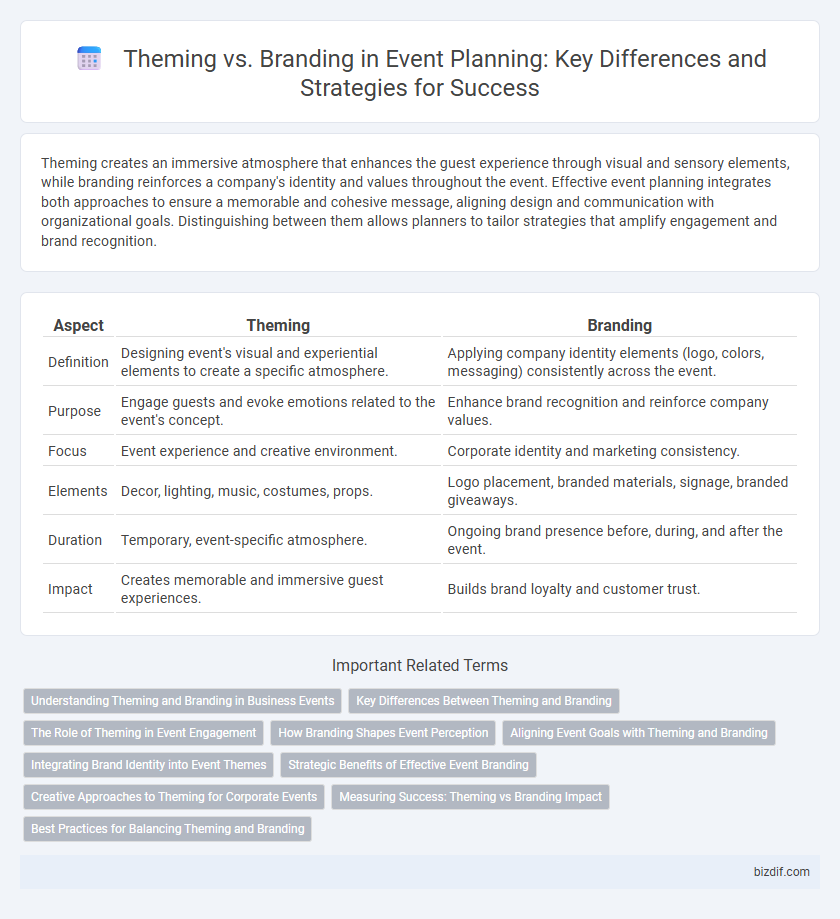Theming creates an immersive atmosphere that enhances the guest experience through visual and sensory elements, while branding reinforces a company's identity and values throughout the event. Effective event planning integrates both approaches to ensure a memorable and cohesive message, aligning design and communication with organizational goals. Distinguishing between them allows planners to tailor strategies that amplify engagement and brand recognition.
Table of Comparison
| Aspect | Theming | Branding |
|---|---|---|
| Definition | Designing event's visual and experiential elements to create a specific atmosphere. | Applying company identity elements (logo, colors, messaging) consistently across the event. |
| Purpose | Engage guests and evoke emotions related to the event's concept. | Enhance brand recognition and reinforce company values. |
| Focus | Event experience and creative environment. | Corporate identity and marketing consistency. |
| Elements | Decor, lighting, music, costumes, props. | Logo placement, branded materials, signage, branded giveaways. |
| Duration | Temporary, event-specific atmosphere. | Ongoing brand presence before, during, and after the event. |
| Impact | Creates memorable and immersive guest experiences. | Builds brand loyalty and customer trust. |
Understanding Theming and Branding in Business Events
Theming in business events focuses on creating a cohesive, immersive atmosphere that aligns with the event's purpose, leveraging visual elements and design to evoke specific emotions from attendees. Branding centers on communicating a company's identity consistently through logos, messaging, and values to reinforce recognition and trust. Understanding the distinction helps event planners craft experiences that both engage guests emotionally and strengthen the company's market presence.
Key Differences Between Theming and Branding
Theming in event planning involves creating an immersive environment centered around a specific concept or idea, enhancing attendee experience through decor, activities, and ambiance. Branding focuses on consistently communicating a company or event's identity, values, and message through logos, colors, and marketing materials to strengthen recognition and loyalty. Key differences include theming's emphasis on sensory and experiential elements, while branding prioritizes identity and strategic communication across multiple touchpoints.
The Role of Theming in Event Engagement
Theming enhances event engagement by creating immersive, memorable experiences that resonate with attendees on an emotional level. Unlike branding, which focuses on consistent messaging and identity, theming uses visual, auditory, and interactive elements to build atmosphere and foster participant interaction. Effective theming increases attendee satisfaction and retention by transforming events into dynamic environments that reflect the event's purpose and audience interests.
How Branding Shapes Event Perception
Branding shapes event perception by creating a cohesive identity that resonates with the target audience, influencing emotional connections and memorability. Consistent use of logos, color schemes, and messaging reinforces brand recognition and trust throughout the event experience. Unlike theming, which focuses on sensory and decorative elements, branding integrates strategic communication to align the event with organizational values and goals.
Aligning Event Goals with Theming and Branding
Aligning event goals with theming and branding ensures a cohesive experience that reinforces the event's purpose and identity. Theming creates a visually immersive atmosphere that resonates emotionally, while branding delivers consistent messaging and recognition. Strategic integration of both elevates attendee engagement and strengthens the event's overall impact.
Integrating Brand Identity into Event Themes
Integrating brand identity into event themes enhances audience recognition and strengthens brand loyalty by creating a cohesive experience that aligns with the company's values and messaging. Effective event theming incorporates key brand elements such as logos, color schemes, and messaging tone to reflect the brand's personality throughout the event space and activities. This strategic alignment ensures the event not only entertains but also reinforces brand positioning and drives meaningful customer engagement.
Strategic Benefits of Effective Event Branding
Effective event branding enhances audience engagement by creating a memorable and consistent identity that resonates beyond the event itself. Strategic branding differentiates the event in a competitive market, driving higher attendance and sponsor interest through clear messaging and visual cohesion. Strong branding also strengthens brand loyalty and trust, turning attendees into long-term advocates and maximizing return on investment.
Creative Approaches to Theming for Corporate Events
Creative approaches to theming for corporate events emphasize immersive experiences that align with company values and audience interests, enhancing engagement beyond traditional branding methods. Utilizing multisensory elements such as visual motifs, interactive installations, and customized decor helps create a memorable atmosphere that reinforces the event's purpose. Integrating storytelling and innovative technology, like augmented reality, deepens emotional connections and amplifies brand messaging in a cohesive yet dynamic thematic presentation.
Measuring Success: Theming vs Branding Impact
Measuring success in event planning requires distinct metrics for theming and branding impact. Theming success is gauged by attendee engagement, emotional resonance, and overall atmosphere alignment with the event's purpose. Branding impact is quantified through brand recall, social media mentions, and post-event surveys reflecting increased brand loyalty and perception.
Best Practices for Balancing Theming and Branding
Effective event planning requires balancing theming and branding to create a cohesive and memorable experience. Best practices include integrating brand colors, logos, and messaging seamlessly within thematic elements while ensuring the theme enhances rather than overshadows the brand identity. Consistent visual design, clear communication, and audience alignment optimize engagement and reinforce brand recognition throughout the event.
Theming vs branding Infographic

 bizdif.com
bizdif.com